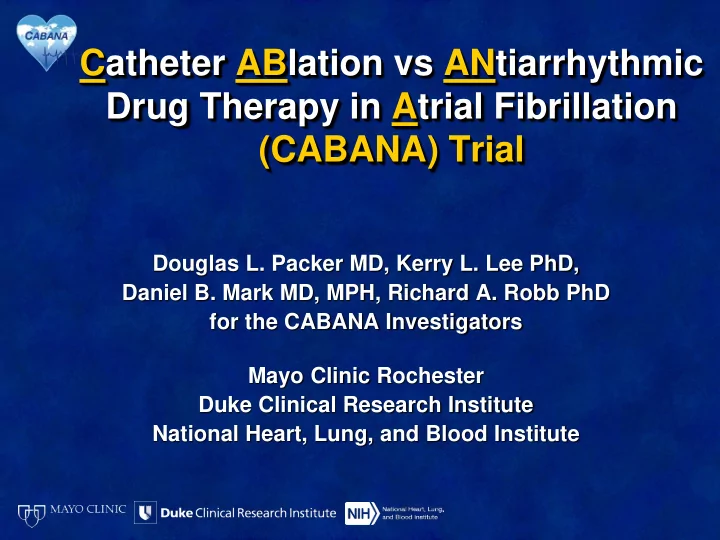

Catheter ABlation vs ANtiarrhythmic Drug Therapy in Atrial Fibrillation (CABANA) Trial Douglas L. Packer MD, Kerry L. Lee PhD, Daniel B. Mark MD, MPH, Richard A. Robb PhD for the CABANA Investigators Mayo Clinic Rochester Duke Clinical Research Institute National Heart, Lung, and Blood Institute
CABANA Trial Funding: • NIH: (U01HL89709, U01HL089786, U01HL089907 and U01HL089645) • St Jude Medical Found. and Corp, • Biosense Webster Inc, JnJ Inc, • Medtronic Corporation, and • Boston Scientific Corporation
Purpose of CABANA Compare Ablation to state-of-the-art drug therapy for patients with new onset / undertreated AF Primary Endpoint All-cause mortality, disabling stroke, serious • bleeding, or cardiac arrest Major Secondary Endpoints All-cause mortality • Death (all-cause) or cardiovascular • hospitalization
CABANA Trial Design Ablation Therapy Enroll patients with new onset or under-treated (1108) paroxysmal, persistent, or Primary ablation: longstanding persistent • PVI/WACA AF who warrant therapy Ancillary ablation: • Linear lesions • CFAE R Key Inclusion Criteria Anticoagulation • ≥ 65 years of age 1:1 • <65 years of age with ≥ 1 CVA/CV risk factor Drug Therapy • Eligible for ablation and (1096) • ≥2 rhythm or rate control • Rate Control or drugs • Rhythm Control • Anticoagulation No Exclusion Criteria Identified
Patient Randomization Subjects 2204 Ablation Therapy Drug Therapy 1108 1096 Drug Treated Ablated 1092 (99.6%) 1006 (90.8%) rhythm control 953 (87.2%) repeat ablation 215 (19.4%) rate control only 126 (11.5%) Not ablated Cross Over Ablated Crossovers 102 (9.2%) 301 (27.5%) Completed FU Completed FU 966 (88%) 48.2 mo 1002 (90.4%) 48.9 mo * Withdrew <3 years
Patient Demographics Ablation Drug Therapy N=1108 N=1096 Age, Median (Q1, Q3) 68 (62, 72) 67 (62, 72) <65 yrs 33.8% 35.7% 65 - 74 52.1% 50.5% >75 14.1% 13.9% Sex (Female) 37.3% 37.0% Minority 10.2% 10.2% BMI, Median (Q1, Q3) 30 (27, 84) 30 (26, 35)
Baseline History in CABANA Ablation Drug Therapy Sleep Apnea 23.6% 22.5% Cardiomyopathy 8.9% 11.2% Congestive Heart Failure 15.7% 14.9% NYHA Class Class I 13.9% 11.6% Class II/III 34.3% 36.7% Prior CVA or TIA 10.6% 9.4%
Arrhythmia History in CABANA AF Type Ablation Drug Therapy Paroxysmal 42.4% 43.5% Persistent 47.3% 47.3% Longstanding Persistent 10.3% 9.2% Years since onset of AF [Median (Q1,Q3)] 1.1 (0.3, 4.1 1.1 (0.3, 3.9) CCS Severity of AF Class 0-1 34.6% 26.7% Class 2 31.8% 32.4% Class 3-4 43.5% 41.0% Prior hospitalization for AF 40.6% 38.8%
Primary Endpoint (Death, Disabling Stroke, Serious Bleeding, or Cardiac Arrest) (ITT)
Estimates of All-Cause Mortality Risk (ITT)
Primary and Secondary Outcomes as Randomized (ITT) Ablation Drug Hazard Ratio P- N = 1108 N = 1096 (95% CI) Value Primary Outcome Composite: 89 (8.0%) 101 (9.2%) 0.86 (0.65, 1.15) 0.30 Death 58 (5.2%) 67 (6.1%) 0.85 (0.60, 1.21) 0.38 Disabling stroke 0.19 3 (0.3%) 7 (0.6%) 0.42 (0.11, 1.62) Serious bleeding 36 (3.3%) 0.98 (0.62, 1.56) 0.93 36 (3.2%) Cardiac arrest 11 (1.0%) 0.62 (0.24, 1.61) 0.33 7 (0.6% Secondary Outcomes All-cause mortality 58 (5.2%) 67 (6.1%) 0.85 (0.60, 1.21) 0.38 Death or CV 573 (51.7%) 637 (58.1%) 0.83 (0.74, 0.93) 0.001 hospitalization
Primary Endpoint Sub-group Analysis All-Cause Mortality, Disabling Stroke, Serious Bleeding, Cardiac Arrest (ITT) * Minority=Hispanic or Latino or non-white race
All-Cause Mortality or Cardiovascular Hospitalization (ITT)
First Recurrence AF – Post Blanking* (ITT) *Using CABANA Monitors
Primary and Secondary Outcomes (Treatment Received)* Ablation Drug Hazard Ratio P- (N = 1307) (N = 897) (95% CI) Value Primary Outcome 92 (7.0%) 98 (10.9%) 0.67 (0.50, 0.89) 0.006 Secondary Outcomes All-cause mortality 58 (4.4%) 67 (7.5%) 0.60 (0.42, 0.86) 0.005 Death or CV 538 (41.2%) 672 (74.9%) 0.83 (0.74, 0.94) 0.002 hospitalization *pre-specified
Primary Endpoint (Death, Disabling Stroke, Serious Bleeding, or Cardiac Arrest (Per Protocol)
Primary Endpoint Sub-group Analysis All-Cause Mortality, Disabling Stroke, Serious Bleeding, Cardiac Arrest (Per Protocol) * Minority=Hispanic or Latino or non-white race
Adverse Events in CABANA
Conclusion of the CABANA Trial • Ablation did not produce a significant reduction in the primary endpoint and all-cause mortality. • The results were affected by cross-overs in both directions and lower than expected event rates. • Ablation significantly reduced mortality or CV hospitalization by 17% compared to drug therapy. • There also was a significant 47% reduction in recurrent AF with ablation compared to drug therapy. • A 33% reduction in the primary endpoint and 40% mortality risk reduction was present when patients actually underwent ablation (treatment received). • Ablation is an acceptable treatment strategy for treating AF with low adverse event rates even in higher risk patients.
Recommend
More recommend